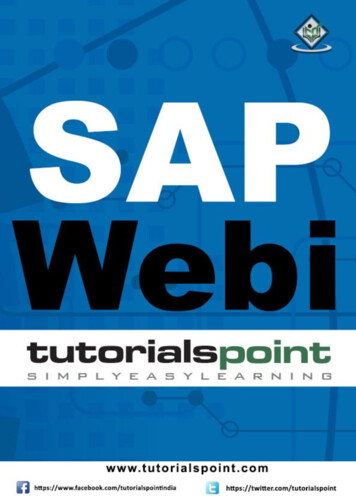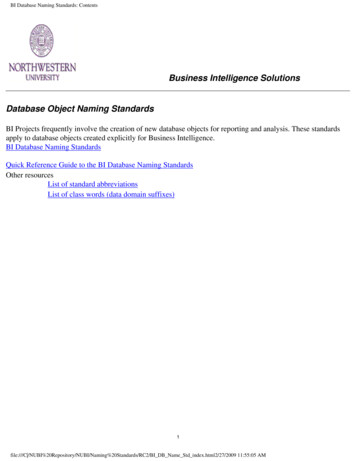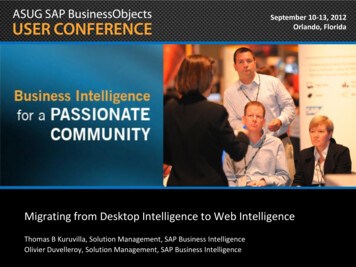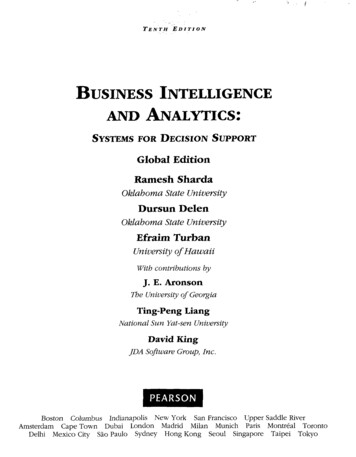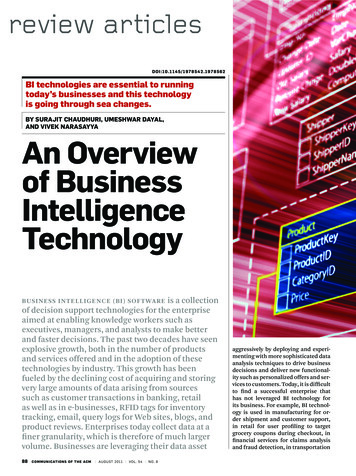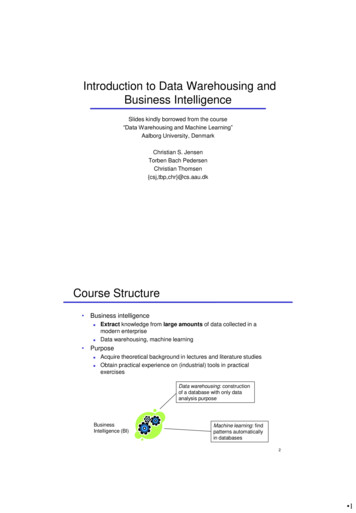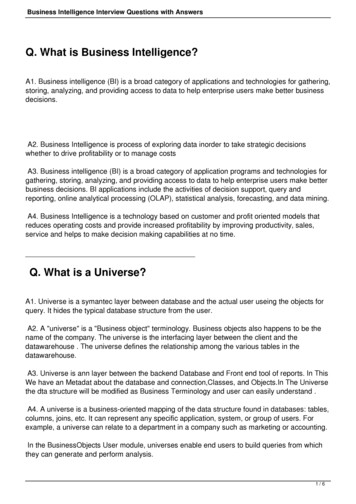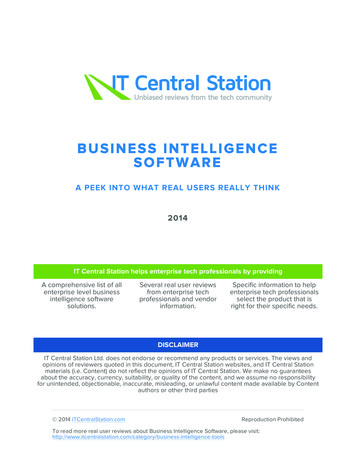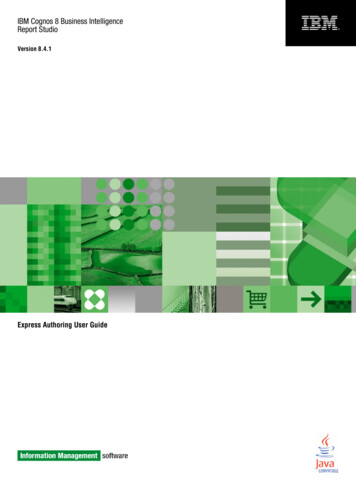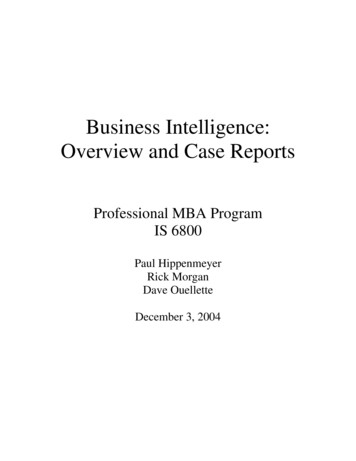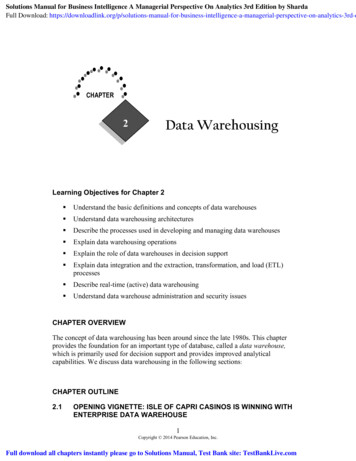
Transcription
Solutions Manual for Business Intelligence A Managerial Perspective On Analytics 3rd Edition by ShardaFull Download: alytics-3rd-eCHAPTERData Warehousing2Learning Objectives for Chapter 2 Understand the basic definitions and concepts of data warehouses Understand data warehousing architectures Describe the processes used in developing and managing data warehouses Explain data warehousing operations Explain the role of data warehouses in decision support Explain data integration and the extraction, transformation, and load (ETL)processes Describe real-time (active) data warehousing Understand data warehouse administration and security issuesCHAPTER OVERVIEWThe concept of data warehousing has been around since the late 1980s. This chapterprovides the foundation for an important type of database, called a data warehouse,which is primarily used for decision support and provides improved analyticalcapabilities. We discuss data warehousing in the following sections:CHAPTER OUTLINE2.1OPENING VIGNETTE: ISLE OF CAPRI CASINOS IS WINNING WITHENTERPRISE DATA WAREHOUSE1Copyright 2014 Pearson Education, Inc.Full download all chapters instantly please go to Solutions Manual, Test Bank site: TestBankLive.com
A.Questions for the Opening VignetteWHAT WE CAN LEARN FROM THIS VIGNETTE2.2DATA WAREHOUSING DEFINITIONS AND CONCEPTSA.WHAT IS A DATA WAREHOUSE?B.A HISTORICAL PERSPECTIVE TO DATA WAREHOUSINGC.CHARACTERISTICS OF DATA WAREHOUSINGD.DATA MARTSE.OPERATIONAL DATA STORESF.ENTERPRISE DATA WAREHOUSES (EDW) Application Case 2.1: A Better Data Plan: Well-EstablishedTELCOs Leverage Data Warehousing and Analytics toStay on Top in a Competitive IndustryG.METADATASection 2.2 Review Questions2.3DATA WAREHOUSING PROCESS OVERVIEW Application Case 2.2: Data Warehousing Helps MultiCareSave More LivesSection 2.3 Review Questions2.4DATA WAREHOUSING ARCHITECTURESA.ALTERNATIVE DATA WAREHOUSING ARCHITECTURESB.WHICH ARCHITECTURE IS THE BEST?Section 2.4 Review Questions2.5DATA INTEGRATION AND THE EXTRACTION, TRANSFORMATION,AND LOAD (ETL) PROCESSESA.DATA INTEGRATION Application Case 2.3: BP Lubricants Achieves BIGSSuccessB.EXTRACTION, TRANSFORMATION, AND LOADSection 2.5 Review Questions2.6DATA WAREHOUSE DEVELOPMENT Application Case 2.4: Things Go Better with Coke’s DataWarehouseA.DATA WAREHOUSE DEVELOPMENT APPROACHES1.The Inmon Model: The EDW Approach2.The Kimball Model: The Data Mart Approach3.Which Model Is Best? Application Case 2.5: Starwood Hotels & Resorts ManagesHotel Profitability with Data WarehousingB.ADDITIONAL DATA WAREHOUSE DEVELOPMENTCONSIDERATIONS Technology Insights 2.1: Hosted Data Warehouses2Copyright 2014 Pearson Education, Inc.
C.D.E.F.REPRESENTATION OF DATA IN DATA WAREHOUSEANALYSIS OF DATA IN DATA WAREHOUSEOLAP VERSUS OLTPOLAP OPERATIONS1.Variations of OLAP Technology Insights 2.2: Hands-On Data Warehousingwith MicroStrategySection 2.6 Review Questions2.7DATA WAREHOUSING IMPLEMENTATION ISSUES Application Case 2.6: EDW Helps Connect State Agenciesin MichiganA.MASSIVE DATA WAREHOUSES AND SCALABILITYSection 2.7 Review Questions2.8REAL-TIME DATA WAREHOUSING Application Case 2.7: Egg Plc Fries the Competition inNear Real Time Technology Insights 2.3: The Real-Time Realities ofActive Data WarehousingSection 2.8 Review Questions2.9DATA WAREHOUSE ADMINISTRATION, SECURITY ISSUES, ANDFUTURE TRENDS Technology Insights 2.4: Ambeo Delivers Proven DataAccess Auditing SolutionA.THE FUTURE OF DATA WAREHOUSINGSection 2.9 Review Questions2.10RESOURCES, LINKS, AND THE TERADATA UNIVERSITY NETWORKCONNECTIONA.RESOURCES AND LINKSB.CASESC.VENDORS, PRODUCTS, AND DEMOSD.PERIODICALSE.ADDITIONAL REFERENCESF.THE TERADATA UNIVERSITY NETWORK (TUN) CONNECTIONChapter HighlightsKey TermsQuestions for DiscussionExercisesTeradata University and Other Hands-On ExercisesTeam Assignments and Role-Playing ProjectsInternet Exercises End of Chapter Application Case: Continental AirlinesFlies High with Its Real-Time Data Warehouse3Copyright 2014 Pearson Education, Inc.
Questions for the CaseReferencesTEACHING TIPS/ADDITIONAL INFORMATION Expect to spend some time on this chapter, as understanding its content is crucial andmany of the concepts are not intuitive to students whose major computer exposure hasbeen at the personal level. You should prepare yourself with some technical examples ofhow things work, such as screen shots from some of the tools mentioned in the chapter,as most of the technical discussion here is at a more conceptual level. The businessdiscussion is tangible, but the technical part is less so. It will be up to you to connect it tothe students.Section 2.2 defines several fundamental concepts. Students must understand that theseare not definitions for the sake of definitions (every textbook has some of those, this oneis no exception) but are important to anyone working in the field. The characteristics of adata warehouse in its extended definition, for example, are given not because someresearcher thought they’d be theoretically nice, but, more specifically, because they’veturned out to be important in practice. So, it’s important to really know what each of themis about. (The concept of an operational data store should already be familiar to students,though perhaps not by that name. They should know what metadata are from their usewith general databases, too.)ANSWERS TO END OF SECTION REVIEW QUESTIONS Section 2.1 Review Questions1.Why is it important for Isle to have an EDW?In the gaming industry, companies distinguish themselves based on their customerrelationships. An enterprise data warehouse (EDW) gathers and provides the dataneeded to tell Isle of Capri what customers respond to, so the casinos can adapttheir offerings. The information provided by the EDW lets Isle deepen itsunderstanding of customers, so it can efficiently give them more of the kinds ofentertainment they are looking for.2.What were the business challenges or opportunities that Isle was facing?Isle of Capri Casinos is one of the largest publicly traded gaming companies inthe United States, but the gaming business is competitive. Other casinos offeressentially the same games, so Isle must find ways to make its entertainment andhospitality atmosphere one that exceeds customer expectations. Before Isleimplemented the EDW, casino managers had to wait to review monthly data untilthe second week of the following month. The time lag made it difficult for casinos4Copyright 2014 Pearson Education, Inc.
to identify what actions were appealing to customers in time to respond. Addingto these business challenges, Hurricane Katrina set back initial efforts to set up adata warehouse at the southeastern company.3.What was the process Isle followed to realize EDW? Comment on the potentialchallenges Isle might have had going through the process of EDW development.Isle of Capri brought in two expert suppliers. Teradata provided the core solution;IBM Cognos provided expertise in business intelligence. Isle hired a managementteam that understood how EDW could support decision making at Isle. That teamwould be able to help Isle’s managers with the challenge of understanding howthey can frame queries and follow-up questions to figure out ways to improve thebusiness. Most likely, the potential of using detailed, up-to-the-minute data wouldbe unfamiliar to many of these managers.4.What were the benefits of implementing an EDW at Isle? Can you think of otherpotential benefits that were not listed in the case?The implementation of EDW brought several benefits related to the timelinessand detail of the data that became available. Instead of five week-old monthlyreports, managers can now study a variety of daily, weekly, and monthly reports.The reports segment data by particular properties and customer groups, somanagers can zero in on particular problems and successes, easily makingcomparisons among properties. Managers can submit queries about data sets andreceive information within minutes. In this way, managers can find out howparticular promotions are affecting customer behavior at particular casinos. TheEDW also connects data about casino activity with data about customers’ use ofhotels and efforts by Isle’s hosts. This, too, helps the company target promotionsand offer customers incentives they value. Even decisions as detailed as where tolocate slot machines can be adjusted to boost profits based on data from the EDW.5.Why do you think large enterprises like Isle in the gaming industry can succeedwithout having a capable data warehouse/business intelligence infrastructure?In the past, businesses in the gaming industry could succeed without a capabledata warehouse/business intelligence infrastructure because their managers knewas much about customers as their competitors’ management knew. They were alltesting ideas for promotion or entertainment and responding to customer behaviorat about the same pace. However, when one company such as Isle begins torespond to daily, property-by-property data, choosing the marketing andentertainment options that deliver exactly what most profitably lures customers,competitors without that capability will soon begin to suffer.Section 2.2 Review Questions1.What is a data warehouse?5Copyright 2014 Pearson Education, Inc.
A data warehouse is defined in this section as “a pool of data produced to supportdecision making.” This focuses on the essentials, leaving out characteristics thatmay vary from one DW to another but are not essential to the basic concept.The same paragraph gives another definition: “a subject-oriented, integrated,time-variant, nonvolatile collection of data in support of management’s decisionmaking process.” This definition adds more specifics, but in every caseappropriately: it is hard, if not impossible, to conceive of a data warehouse thatwould not be subject-oriented, integrated, etc.2.How does a data warehouse differ from a database?Technically a data warehouse is a database, albeit with certain characteristics tofacilitate its role in decision support. Specifically, however, it is (see previousquestion) an “integrated, time-variant, nonvolatile, subject-oriented repository ofdetail and summary data used for decision support and business analytics withinan organization.” These characteristics, which are discussed further in the sectionjust after the definition, are not necessarily true of databases in general—thougheach could apply individually to a given one.As a practical matter most databases are highly normalized, in part to avoidupdate anomalies. Data warehouses are highly denormalized for performancereasons. This is acceptable because their content is never updated, just added to.Historical data are static.3.What is an ODS?Operational Data Store is the database from which a business operates on an ongoing basis.4.Differentiate among a data mart, an ODS, and an EDW.An ODS (Operational Data Store) is the database from which a business operateson an ongoing basis.Both an EDW and a data mart are data warehouses. An EDW (Enterprise DataWarehouse) is an all-encompassing DW that covers all subject areas of interest tothe entire organization. A data mart is a smaller DW designed around oneproblem, organizational function, topic, or other suitable focus area.5.Explain the importance of metadata.Metadata, “data about data,” are the means through which applications and usersaccess the content of a data warehouse, through which its security is managed,and through which organizational management manages, in the true sense of the6Copyright 2014 Pearson Education, Inc.
word, its information assets. Most database management systems would be unableto function without at least some metadata. Indeed, the use of metadata, whichenable data access through names and logical relationships rather than physicallocations, is fundamental to the very concept of a DBMS.Metadata are essential to any database, not just a data warehouse. (See answer toReview Question 2 of this section above.)Section 2.3 Review Questions1.Describe the data warehousing process.The data warehousing process consists of the following steps:1.Data are imported from various internal and external sources2.Data are cleansed and organized consistently with the organization’s needs3.a.Data are loaded into the enterprise data warehouse, orb.Data are loaded into data marts.4.a.If desired, data marts are created as subsets of the EDW, orb.The data marts are consolidated into the EDW5.Analyses are performed as needed2.Describe the major components of a data warehouse. 3.Data sources. Data are sourced from operational systems and possiblyfrom external data sources.Data extraction and transformation. Data are extracted and properlytransformed using custom-written or commercial software called ETL.Data loading. Data are loaded into a staging area, where they aretransformed and cleansed. The data are then ready to load into the datawarehouse.Comprehensive database. This is the EDW that supports decision analysisby providing relevant summarized and detailed information.Metadata. Metadata are maintained for access by IT personnel and users.Metadata include rules for organizing data summaries that are easy toindex and search.Middleware tools. Middleware tools enable access to the data warehousefrom a variety of front-end applications.Identify and discuss the role of middleware tools.Middleware tools enable access to the data warehouse. Power users such asanalysts may write their own SQL queries. Others may access data through amanaged query environment. There are many front-end applications that businessusers can use to interact with data stored in the data repositories, including data7Copyright 2014 Pearson Education, Inc.
mining, OLAP, reporting tools, and data visualization tools. All these have theirown data access requirements. Those may not match with h
B. A HISTORICAL PERSPECTIVE TO DATA WAREHOUSING C. CHARACTERISTICS OF DATA WAREHOUSING D. DATA MARTS E. OPERATIONAL DATA STORES F. ENTERPRISE DATA WAREHOUSES (EDW) Application Case 2.1: A Better Data Plan: Well-Established TELCOs Leverage Data Warehousing and Analytics to Stay on Top in a Competitive Industry G. METADATA
